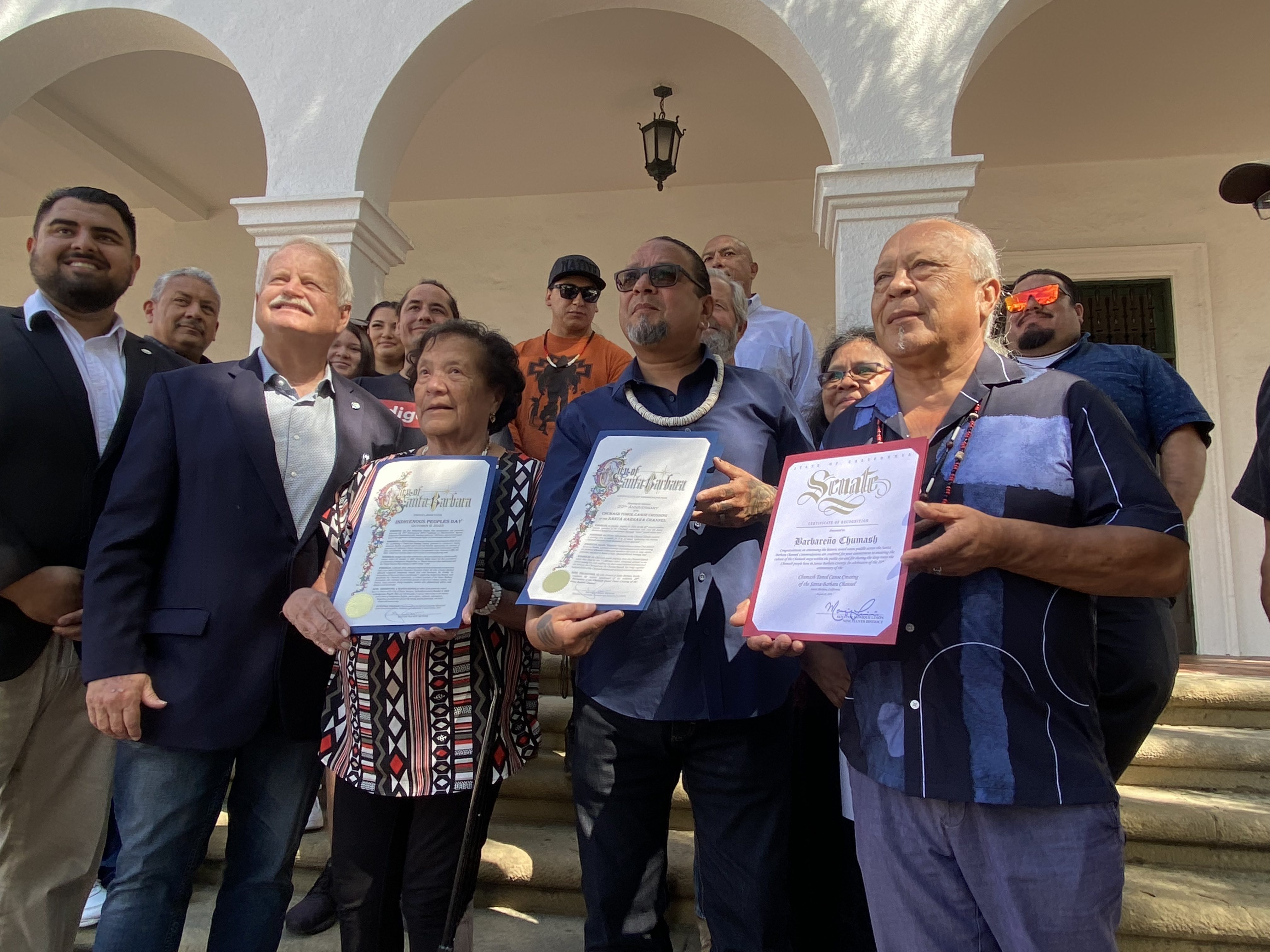City of Santa Barbara Honors Chumash on Indigenous Peoples’ Day
City Leaders Gather with Chumash Elders to Recognize Anniversary of Tomol Crossing to Channel Islands

On Monday, Chumash tribal leaders and elders gathered on the front steps of Santa Barbara City Hall, where they stood alongside Mayor Randy Rowse and Councilmember Oscar Gutierrez to receive recognition on what is now officially Indigenous Peoples’ Day.
For decades, there has been a nationwide push to celebrate Native American history and culture on the second Monday of October, the day typically observed as Columbus Day. In 2021, President Joe Biden issued the first-ever presidential proclamation of Indigenous Peoples’ Day, starting a domino effect of cities and states pivoting away from celebrating Columbus Day and toward celebrating indigenous people.
Mayor Rowse introduced the resolution officially recognizing Indigenous Peoples’ Day in Santa Barbara, “affirming Indigenous people, specifically the Chumash,” he said, “as valued members of the Santa Barbara community who continue to contribute greatly to the area’s vibrant culture.”
With the resolution, Santa Barbara joined several California cities and dozens across the country that recognize Indigenous Peoples’ Day. Mayor Rowse said that he hopes that the holiday will inspire residents to “educate themselves on the history of culture of Indigenous people and to honor, celebrate, and support Indigenous populations, in particular, the Chumash people.”
In addition to recognizing the holiday, the city also celebrated the Chumash for the 20th anniversary of the traditional tomol crossing from Santa Barbara to Santa Cruz Island, a pilgrimage thousands of years old that was brought back by members of the Chumash community in 2001. Since then, Chumash paddlers have recreated the 24-mile journey each year (with the exception of 2021 and 2022, which were canceled due to the pandemic).
Toni Cordero, one of the Chumash paddlers who helped “reawaken the tomols,” as she said, was there with several other tomol captains to accept the certificates of commendation signed by the city and by State Senator Monique Limón.
“The crossing and the tomols are hugely significant to our community, not only because it gives us a chance to honor our past and our ancestors; it gives us an opportunity to reconnect with our culture, with our beloved Limuw — what you know as Santa Cruz Island — and with each other,” Cordero said.
The revival of the tomol tradition, she said, has also encouraged a new generation of Chumash to help carry on the culture. Nowadays, it’s common to see up to three generations of Chumash paddling together.
“We now have young people who have never known a time when we didn’t have this powerful annual gathering. This is part of their normal,” Cordero said of the tomol crossings. “It is a crucially important opportunity for us to ensure that we continue our culture, that we continue to pass down important powerful knowledge to the next generation.”
Chair Reggie Pagaling of the Native American Heritage Commission, a tribal elder of the Santa Ynez Band of Chumash who was also at the ceremony, said he was “proud” to see the community “living out their heritage” with the tomol crossings.
Tomol captain Marcus Lopez Sr. said that the city honoring the Chumash shows that the government is willing to make amends for decades of “dehumanization” of Indigenous people. This healing process is something that has been sponsored at the state level by Governor Gavin Newsom, who signed an executive order in 2019 to start the “Truth & Healing Council” as a way to clarify the historical record with input from Indigenous people, given that the State of California, according to Newsom’s order, “has never formally apologized for historical wrongs tolerated, encouraged, subsidized, and committed by State actors against California Native Americans.”
Lopez asked that the city and county leadership and local residents consider how to approach this healing effort and how to better include Indigenous people in decisions, “whether it be from the recognized bands or whether it be the other bands within the whole area of Chumash territory from Morro Bay all the way to Malibu.”
“It’s incredible that we’re still here. It’s incredible that we participate in a system which is foreign to us, but yet we participate,” Lopez said. “What does healing mean for all of our community? What’s healing mean for our peoples?”



